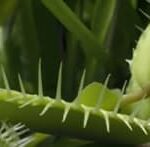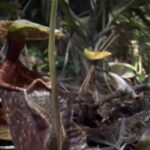As an Amazon Associate, this site earns commissions from qualifying purchases. For more details, click here.
Pitcher plants and bug eating seemingly go hand in hand. That is why they are called carnivorous plants after all, because they eat insects. But do these plants actually have to do that? What will happen if you do not give them any bugs? This a question that often comes up so we will answer that in detail here.
Pitcher plants will survive without eating bugs because they can create food through photosynthesis. But insects provide additional nutrients that speed up plant growth and fight disease.
How Pitcher Plants Survive without Bugs
Because pitcher plants are carnivorous, they need to eat bugs to survive right? Actually they do not. Unlike carnivorous animals, these plants can make their own food.
As long as a pitcher plant has access to light, water and air, it can produce glucose. Glucose is plant food and provides the energy they need. In a healthy environment, carnivorous plants will continue to live even if they do not eat insects.
Because insects are often referred to as food instead of nutrients, their role is confused with that of glucose. While the two have similar functions, there are differences as well.
Nepenthes, sarracenia and other pitcher plants use photosynthesis. Glucose performs many functions for plants and you can compare it to food for animals. Strictly speaking, plants do not consume glucose like food because their digestive process is different from animals. This is why some refer to glucose as fuel for plants instead of food.
The point is, glucose provides pitcher plants the energy they need to live. Combined with a healthy environment and carnivorous plants will live.
By healthy we mean at least 6 hours of sunlight, 50% humidity or higher and temperature of at least 65 F (18 C) up to 85 F (29 C) for nepenthes or 90 F (32 C) for sarracenia. If your plant is indoors, grow lights are a good substitute for sunlight. One we can recommend is Roleadro Grow Lights because it provides enough light without being too harsh.
Under optimum conditions pitcher plants will grow and thrive even with very little nutrients. If you are new to carnivorous plants, location is far more important than feeding. A pitcher plant growing in the right location but eats little will be healthier than a well fed plant growing in a poor environment.
If feeding is your main concern, it should not be. Focus on setting up the right location for your plant first. Keep in mind that nepenthes is tropical while sarracenia is perennial. Adjust their location accordingly.
Why You Should Feed Bugs to Pitcher Plants
So if pitcher plants can live without eating bugs, why should you still feed them? While these plants will live minus insect feeding, there are many good reasons why they must feed.
Pitcher plants need nutrients to stave off infection, germinate and produce traps. A well fed pitcher plant in a healthy location ensures optimum growth and a long lifespan.
Glucose can and does supply plants with energy. But nutrients are also vital to keep them strong. Think of a typical houseplant for example. We plant them in rich soil so it gets nitrogen and other important nutrients. These nutrients, combined with glucose, makes the plant healthier.
Benefits of Insect Nutrients For Pitcher Plants
Carnivorous plants also take advantage of nutrients. They use it with glucose to create more traps, leaves, flower, nectar etc. They can do this with glucose alone but it will take more time.
Without nutrients, pitcher plants have limited resources and will prioritize those that keep it alive. That means sacrificing its growth and development. By providing nutrients to pitcher plants, they will have enough resources to perform daily functions and keep growing.
Pitcher plants eat many types of insects, but they avoid pollinators. Honey bees helps with pollination so the plant takes steps to avoid eating them. They often feed on crawling bugs as flying insects are usually pollinators. However, the plant will eat a pollinator if it falls into one of the pitchers. This is very rare but it can happen.
These insects provide the same type of nutrients that rich soil does. However you cannot substitute one for the other. You cannot plant a nepenthes in rich soil and stop feeding them for instance. Carnivorous plants have become so accustomed to poor soil they cannot live on fertilized media.
Other Nutrient Sources Besides Bugs
So bugs, while not necessary for survival, are still important for pitcher plants because of their nutrition. But can you provide other sources of nutrition?
Pitcher plants get their nutrition from insects. But fish food and mealworms -frozen, freeze dried or live – are also just as good. Occasionally carnivorous plants will eat a small frog, lizard or even snails as well.
Since pitcher plants naturally feed on insects, that should be your first option. If your plants are outdoors they are probably feeding on these bugs already. You can look into the pitchers and if you see remains of insects, that means the plant is eating. No need to give it any more food.
But if your pitcher plant is indoors, you need to give it food. If you do not want to deal with live or dead bugs, buy some fish food or mealworms or fish food.
There are a lot of fish food to choose from but Aqueon Pro Foods Betta Fish Food are especially popular with carnivorous plant growers. You should mist the pellets with water before dropping it in the pitcher. Do not fill the trap, just a few will do.
Both mealworms and bloodworms are good sources of nutrition for pitcher plants. They can be frozen, live or freeze dried. Live worms are the most nutritious but have a very short shelf life. If you put too many in the pitcher and the plant does not eat them all, they could rot.
Frozen and freeze dried worms are a better option. Make sure to thaw them first according to the instructions on the package. Again, you only need to give one or two. Even a small amount will last these plants a long time.
How to Keep Pitcher Plants Healthy
With enough nutrients plus glucose,your pitcher plants will live longer and be more responsive to prey. They will be easier to propagate and be less vulnerable to diseases.
Caring for pitcher plants can seem like a daunting task, but it does not have to be. There are many steps you can take to simplify the process without compromising the health of your plants.
Provide as much light as possible for the best results. Nepenthes prefer partial and direct light, while sarracenia needs full direct light, preferably outdoors. All pitcher plants require moist sol and high humidity.
If you have just bought a pitcher plant, give it time to get used to its new environment. Keep the plant in its container for a few days. Leave it on a sunny windowsill with lots of humidity. You can install a humidifier to keep the level to at least 50%.
Do not panic if the plant refuses to eat at first. Once it has gotten used to its environment, the plant will start feeding again. Remember that only indoor pitcher plants need to be given any food.
If you have a tropical pitcher plant, try to keep the temperature around 65 to 85 F. They will not survive freezing winters so they should be indoors during winter. You can feed them all year round.
Never put food for human consumption in the pitchers. The best case scenario is the plant will not eat it. The worst case is the plant does consume it and the pitcher dies as a result.
Perennial pitcher plants like sarracenia do not eat during dormancy. They will only emerge during spring so their hibernation period can last 3 months or more. Once they come back in spring, you can repot, divide or propagate the plant.
Conclusion
Many people worry about how much to feed their pitcher plants. But as we have explained here, you just need to focus on its environment. The key is to provide a healthy place for its growth, and coupled with feeding for the best results.

My fascination with carnivorous plants began many, many years ago with Venus Fly Traps. Now I am more than happy to impart what I know with other enthusiasts and those who are curious about meat eating plants.



